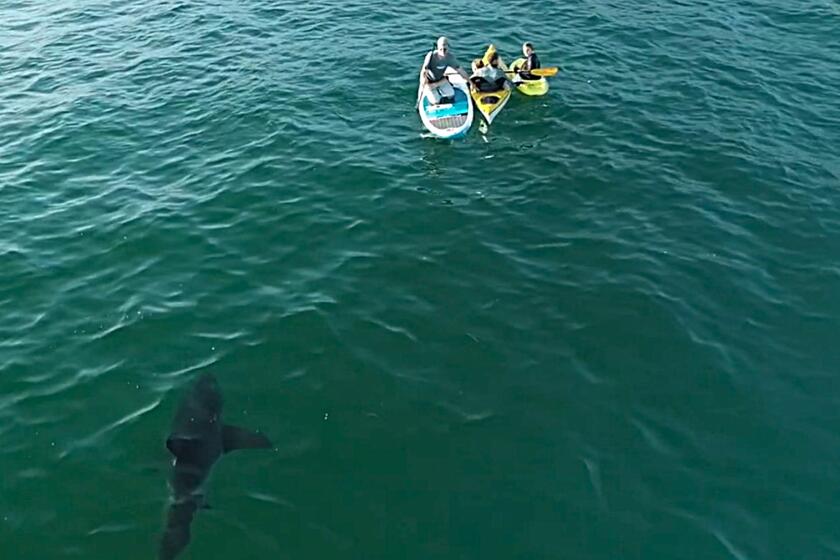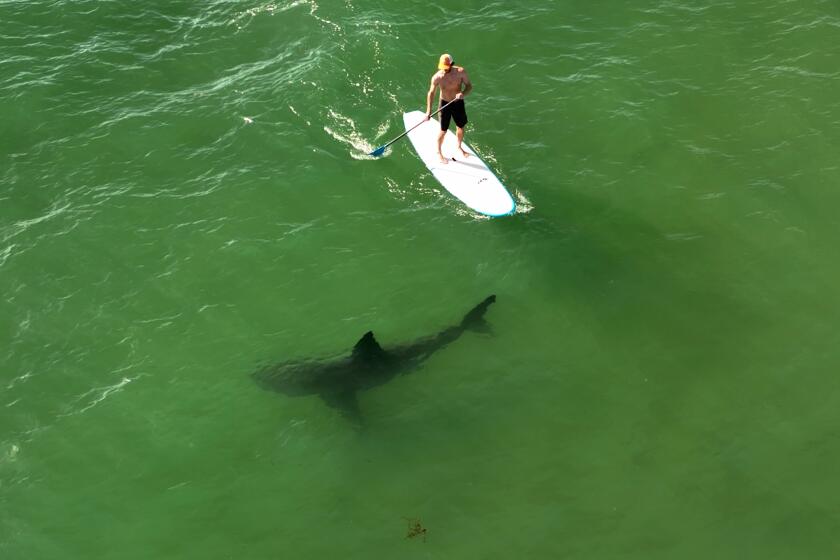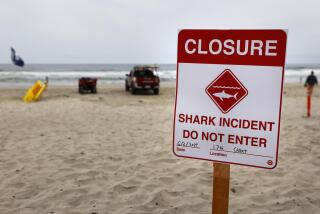‘Incredibly hungry’ sharks attack Netflix crew filming ‘Our Planet II’
- Share via
Did Netflix’s “Our Planet II” crew jump the shark?
The series’ producers recently revealed a close encounter with hungry 15-foot tiger sharks, and how they narrowly escaped with only an inflatable boat as a barrier between themselves and the predators.
“Our Planet II” producer and director Toby Nowlan spoke with Radio Times last week and described the harrowing encounter.
“This ’V’ of water came streaming toward us and this tiger shark leapt at the boat and bit huge holes in it. The whole boat exploded,” Nowlan told the outlet. “We were trying to get it away and it wasn’t having any of it. It was horrific. That was the second shark that day to attack us.”
For the first episode of the four-part series, the crew traveled to the northwestern Hawaiian island of Laysan, more than 600 miles from the main Hawaiian Islands, sailing for six days to a remote location where they say no one has filmed before.
A new study documents how closely the high-profile sharks swim near humans in coastal waters.
The series focuses this season on wildlife migration and Laysan is a breeding hub for the Laysan albatross, a large seabird that calls the North Pacific home. On the island, the albatross chicks are cared for by their parents until they’re around 6 months old and the wind picks up enough to assist the heavy birds on their first flight.
According to the documentary, when North Pacific ocean temperatures reach their peak toward the end of summer, and the nearly full-fledged albatross chicks are gearing up to brave the ocean in search of food, tiger sharks sense the shift and change course, heading straight for Laysan.
Huw Cordey, the series producer, told Forbes that they’d ventured into the shark-infested waters to spend six weeks following the trials and tribulations of a single albatross chick.
“The shoot itself was very interesting: It took six days to sail there from Hawaii, and I believe we are the first natural history series to film the maiden flight of a Laysan albatross. They’re the longest-lived birds of all, and they take this enormous journey around the planet for years before they breed for the first time,” Cordey told the outlet.
“The original idea was to do an underwater shoot with the tiger sharks waiting in the shallows at Laysan, but the first day the tiger sharks were around, the crew got into these inflatable boats, and two sharks attacked them. It was like something out of ‘Jaws.’”
If you have swum in the ocean off the coast of Santa Barbara or San Diego recently, chances are you swam next to a young great white shark.
In one of the attacks, the boat began to deflate, as the shark had bitten chunks out of it, but fortunately the panicked crew was about 100 yards from land and able to make an “emergency landing” on the sand, where they patched up their boat.
According to Nowlan, the tiger sharks’ behavior was “extremely unusual.”
“They were incredibly hungry, so there might not have been enough natural food and they were just trying anything they came across in the water.”
Nowlan doesn’t seem to harbor any ill will toward the underwater predators. He posted a shot of himself on Instagram in scuba gear clutching an underwater camera with a massive shark beside him. “Hanging out with this lovely specimen we chanced across — an oceanic white-tip, an open ocean wanderer,” he captioned the photo. “Feel like sharks could use some better PR right now.”
“Our Planet II” premiered Wednesday on Netflix. The series is narrated by David Attenborough and “unravels the mystery of how and why animals migrate.”
More to Read
The biggest entertainment stories
Get our big stories about Hollywood, film, television, music, arts, culture and more right in your inbox as soon as they publish.
You may occasionally receive promotional content from the Los Angeles Times.













